holy sonnet 10
- 格式:doc
- 大小:58.00 KB
- 文档页数:5
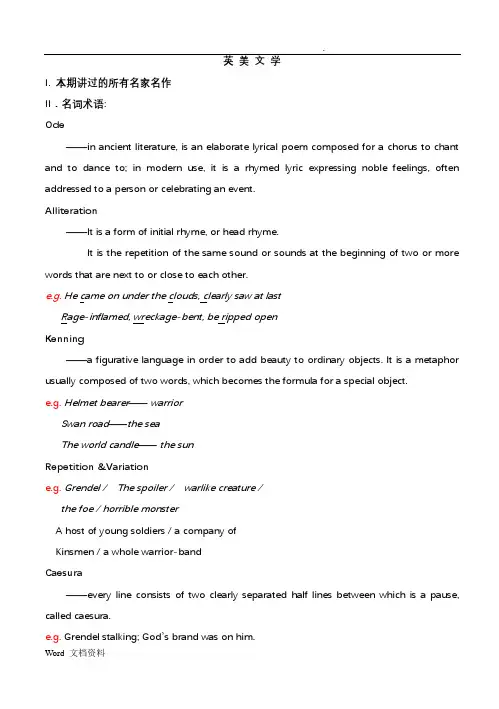
英美文学I. 本期讲过的所有名家名作II.名词术语:Ode——in ancient literature, is an elaborate lyrical poem composed for a chorus to chant and to dance to; in modern use, it is a rhymed lyric expressing noble feelings, often addressed to a person or celebrating an event.Alliteration——It is a form of initial rhyme, or head rhyme.It is the repetition of the same sound or sounds at the beginning of two or more words that are next to or close to each other.e.g. He came on under the clouds, clearly saw at lastRage-inflamed, wreckage-bent, be ripped openKenning——a figurative language in order to add beauty to ordinary objects. It is a metaphor usually composed of two words, which becomes the formula for a special object.e.g. Helmet bearer—— warriorSwan road——the seaThe world candle—— the sunRepetition &Variatione.g. Grendel / The spoiler / warlike creature /the foe / horrible monsterA host of young soldiers / a company ofKinsmen / a whole warrior-bandCaesura——every line consists of two clearly separated half lines between which is a pause, called caesura.e.g. Grendel stalking; God’s brand was on him.the gold-hall of men, the mead-drinking placenailed with gold plates. That was not the first visitBallad——is a form of verse, often a narrative set to music. Ballads were particularly characteristic of the popular poetry and song of the British Isles from the later medieval period until the 19th century and used extensively across Europe and later the Americas, Australia and North Africa. Many ballads were written and sold as single sheet broadsides. The form was often used by poets and composers from the 18th century onwards to produce lyrical ballads. In the later 19th century it took on the meaning of a slow form of popular love song and the term is now often used as synonymous with any love song, particularly the pop or rock power ballad.Epic——is a lengthy narrative poem, ordinarily concerning a serious subject containing details of heroic deeds and events significant to a culture or nation. The first epics are known as primary, or original, epics. One such epic is the Old English story Beowulf. Epics that attempt to imitate these like Milton’s Paradise Lost are known as literary, or secondary, epics.➢The six main characteristics:1. The hero is outstanding. He might be important, and historically or legendarily significant.2. The setting is large. It covers many nations, or the known world.3. The action is made of deeds of great valor or requiring superhuman courage.4. Supernatural forces—gods, angels, demons—insert themselves in the action.5. It is written in a very special style.6. The poet tries to remain objective.Sonnet (Italian Sonnet, Shakespearean Sonnet, Spenserian Sonnet, Miltonic Sonnet)①Italian sonnet❖created by Giacomo da Lentini, head of the Sicilian School.❖Petrarch (1304-1374) most famous early sonneteer❖It falls into two main parts:❖an octave rhyming “abbaabba” (set up a problem ) + volta❖followed by a sestet rhyming “cdecde” or some variant, such as “cdccdc” (answer)②English / Shakespearean sonnet❖The greatest practitioner: William Shakespeare❖three quatrains followed by a couplet❖often presents a repetition-with-variation of a statement in each of the three quatrains ❖The final couplet in the English sonnet usually imposes an epigrammatic turn at the end.——a fourteen-line poem of iambic pentameters. This form is made up of 3 quatrains and a couplet, rhyming:ababcdcdefefgg③Spenserian sonnet❖A variant on the English form is the Spenserian sonnet, named after Edmund Spenser❖three quatrains connected by the interlocking rhyme scheme and followed by a couplet ❖the rhyme scheme is abab, bcbc, cdcd, ee——has the rhyme scheme ababbcbccdcdee and no break between the octave (an eight line stanza) and the sestet( a six line stanza). It is named after the Elizabethan poet Edmund Spenser.④Miltonic SonnetConceit——in literature, a conceit is an extended metaphor with a complex logic that governs a poetic passage or entire poem. By juxtaposing, usurping and manipulating images and ideas in surprising ways, a conceit invites the reader into a more sophisticated understanding of an object of comparison. Extended conceits in English are part of the poetic idiom of Mannerism, during the later sixteenth and early seventeenth century.Simile—is a figure of speech which makes a comparison between two unlike elements hav ing at least one quality or characteristic in common.Simile is almost always introduced by th e following words:like,as,as…as,as it were,as if,as though,be something of,similar to,etc.Metaphor—is a figure of speech where comparison is implied.It is also a comparison between two unlike elements with a similar quality.But unlike a simile,this comparison is implied,not expressed with the word"as"or"like".Symbol——In literary usage, a symbol is a specially evocative kind of image: that is, a word or phrase referring to a concrete object, scene, or action which also has some further significance associated with it.➢Types of SymbolsI. Universal or cultural symbols/traditional symbolsare those whose associations are the common property of a society or culture and are so widely recognized and accepted that they can be said to be almost universal.e.g. water—lifeSerpent—the DevilLamb—Jesus ChristII. Contextual, Authorial, or Private symbolsare those whose associations are neither immediate nor traditional; instead, they derive their meaning, largely if not exclusively, from the context of the work in which they are used.e.g. the albatross in Coleridge’s “The Rime of the Ancient Mariner”Synecdoche——a figure of speech in which a part is substituted for a whole or a whole for a part e.g. My baby woke for a bottle. [提喻用部分代替全体,或用全体代替部分,或特殊代替一般.] Oxymoron——is a figure of speech that juxtaposes elements that appear to be contradictory. Oxymora appear in a variety of contexts, including inadvertent errors (such as "ground pilot") and literary oxymorons crafted to reveal a paradox. The most common form of oxymoron involves an adjective–noun combination of two words. For example, the following line from Tennyson's Idylls of the King contains two oxymora: And faith unfaithful kept him falselye.g. painful pleasure a thunderous silencePun——The pun, also called paronomasia, is a form of word play that suggests two or more meanings, by exploiting multiple meanings of words, or of similar-sounding words, for an intended humorous or rhetorical effect. Puns are used to create humor and sometimes require a large vocabulary to understand. Puns have long been used by comedy writers, such as William Shakespeare, Oscar Wilde, and George Carlin.➢Puns can be classified in various ways:①The homophonic pun, a common type, uses word pairs which sound alike (homophones) but are not synonymous.②A homographic pun exploits words which are spelled the same (homographs) but possess different meanings and sounds.③Homonymic puns, another common type, arise from the exploitation of words which are both homographs and homophones.④A compound pun is a statement that contains two or more puns.⑤A recursive pun is one in which the second aspect of a pun relies on the understanding of an element in the first.⑥Visual puns are used in many logos, emblems, insignia, and other graphic symbols, in which one or more of the pun aspects are replaced by a picture.Personification——a figure of speech which represents abstractions or inanimate objects with human qualities, including physical, emotional, and spiritual; the application of human attributes or abilities to nonhuman entities.ExaggerationDramatic monologue——a kind of poem in which the speaker is imagined to be addressing a silent audience——in its broadest sense, is a rhetorical device,literary technique, or event characterized by an incongruity, or contrast, between what the expectations of a situation are and what is really the case.——A subtly humorous perception of inconsistency, in which an apparently straightforward statement or event is undermined by its context so as to give it a very different significance.Allusion——is a figure of speech, in which one refers covertly or indirectly to an object or circumstance from an external context. It is left to the reader or hearer to make the connection; where the connection is detailed in depth by the author, it is preferable to call it "a reference". Literary allusion is closely related to parody and pastiche, which are also "text-linking" literary devices. A type of literature has grown round explorations of the allusions in such works as Alexander Pope's The Rape of the Lock or T. S. Eliot's The Waste Land. James JoyceRomanticism——Romanticism was an artistic, literary and intellectual movement that originated in the second half of the 18th century in Europe. In part, it was a revolt against aristocratic social and political norms of the Age of Enlightenment and a reaction against the scientific rationalization of nature.It was embodied most strongly in the visual arts, music, and literature.Modernism——Modernism is a rather vague term which is used to apply to the works of a group of poets, novelists, painters, and musicians between 1910 and the early years after the World War II. The term includes various trends or schools, such as imagism, expressionism, dadaism, stream of consciousness, and existentialism. It means a departure from the conventional criteria or established values of the Victorian age.➢The basic themes of modernism:1. Alienation and loneliness are the basic themes of modernism. In the eyes of modernist writers, the modern world is a chaotic one and is incomprehensible.2. Although modern society is materially rich, it is spiritually barren. It is a land of spiritual and emotional sterility.3. Human beings are helpless before an incomprehensible world and no longer able to do things their forefathers once did.➢The characteristics of modernism:1. Complexity and obscurity: (juxtaposition, no limitation of space)2. The use of symbols: (symbol: a means to express their inexpressible selves)3. Allusion: (Allusion is an indirect reference to another work of literature, art, history, or religion.)4. Irony: (an expression of one’s meaning by using words that mean the direct opposite of what one really intends to convey.)Rhyme scheme——the pattern in which the rhymed line-endings are arranged in a poem or stanza. Head rhyme: As busy as a beeEnd rhymeCrossed rhymeWill ye bridle the deep sea with reins, will ye chasten the high sea with rods?Will ye take her to chain her with chains, who is older than all ye Gods?Internal rhyme:“Once upon a midnight dreary, while I pondered, weak and weary"Iambic meter/ trochaic meter/anapestic meter❖Iamb is a metrical unit (foot) of verse❖about [ə'baʊt] =ə+'baʊt❖[ə'baʊt]❖an unstressed syllable(˘) +a stressed syllable(׳)❖=one iambic foot/meter❖About about about about about❖=iambic pentameter抑扬格(iambic):如果一个音步中有两个音节,前者为轻,后者为重,则这种音步叫抑扬格音步,其专业术语是(iamb, iambic.)。
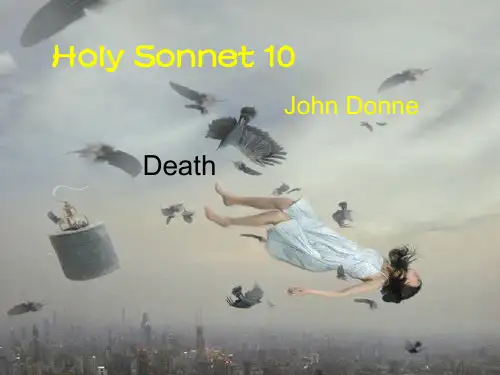
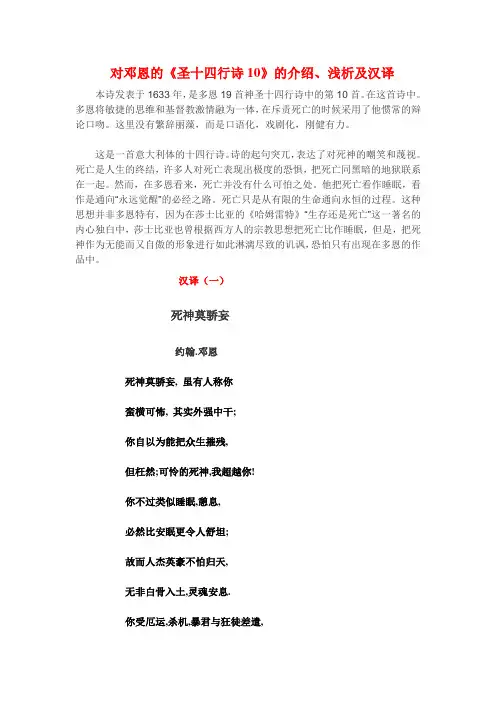
对邓恩的《圣十四行诗10》的介绍、浅析及汉译本诗发表于1633年,是多恩19首神圣十四行诗中的第10首。
在这首诗中。
多恩将敏捷的思维和基督教激情融为一体,在斥责死亡的时候采用了他惯常的辩论口吻。
这里没有繁辞丽藻,而是口语化,戏剧化,刚健有力。
这是一首意大利体的十四行诗。
诗的起句突兀,表达了对死神的嘲笑和蔑视。
死亡是人生的终结,许多人对死亡表现出极度的恐惧,把死亡同黑暗的地狱联系在一起。
然而,在多恩看来,死亡并没有什么可怕之处。
他把死亡看作睡眠,看作是通向“永远觉醒”的必经之路。
死亡只是从有限的生命通向永恒的过程。
这种思想并非多恩特有,因为在莎士比亚的《哈姆雷特》“生存还是死亡”这一著名的内心独白中,莎士比亚也曾根据西方人的宗教思想把死亡比作睡眠,但是,把死神作为无能而又自傲的形象进行如此淋漓尽致的讥讽,恐怕只有出现在多恩的作品中。
汉译(一)死神莫骄妄约翰.邓恩死神莫骄妄, 虽有人称你蛮横可怖, 其实外强中干;你自以为能把众生摧残,但枉然;可怜的死神,我超越你!你不过类似睡眠,憩息,必然比安眠更令人舒坦;故而人杰英豪不怕归天,无非白骨入土,灵魂安息.你受厄运,杀机,暴君与狂徒差遣,用毒药,战争和疾病害人;鸦片与妖术也能使人昏,且更灵验,你何必如此气焰!凡人了却浮生,但精神永生,超脱死的魔掌,灭绝死神!从诗的结构来看,第一、二行“死亡,不要骄傲,虽然有人说你/强大而又可怖,而你并不真的这样”,是论点,而第二行到第八行是论据,说明死亡没有什么可怕,死亡同睡眠没有多少不同,都可以使人“获得身体的休息,灵魂的解脱”。
第九、十行指出死神的无能,而第十一、二行说明死神并没有什么独特之处,没有什么可资骄傲的理由。
这四行进一步提供论据,来支持诗人的论点。
第十三、四行则是结论。
虽然这首诗有很强的论说性,但表达了诗人对死神的蔑视和无畏之情。
情与理的结合使诗本身具有有说服力,而比喻的运用使这篇说理的诗生动。
整个诗作铿锵有力,富于阳刚之气。
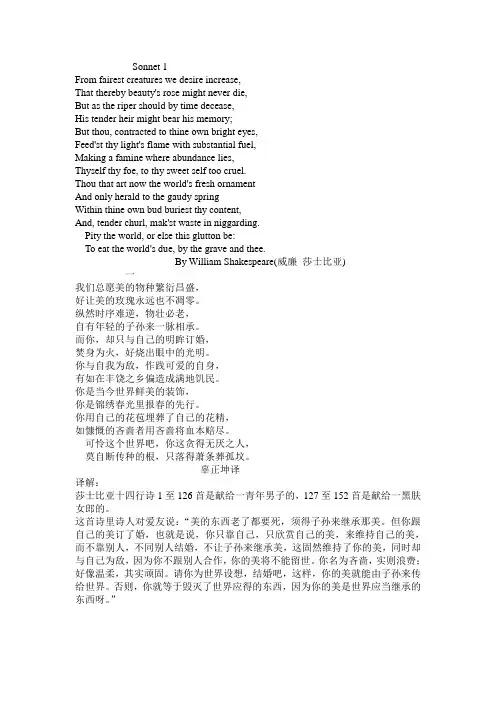
From fairest creatures we desire increase,That thereby beauty's rose might never die,But as the riper should by time decease,His tender heir might bear his memory;But thou, contracted to thine own bright eyes,Feed'st thy light's flame with substantial fuel,Making a famine where abundance lies,Thyself thy foe, to thy sweet self too cruel.Thou that art now the world's fresh ornamentAnd only herald to the gaudy springWithin thine own bud buriest thy content,And, tender churl, mak'st waste in niggarding.Pity the world, or else this glutton be:To eat the world's due, by the grave and thee.By William Shakespeare(威廉莎士比亚)一我们总愿美的物种繁衍昌盛,好让美的玫瑰永远也不凋零。
纵然时序难逆,物壮必老,自有年轻的子孙来一脉相承。
而你,却只与自己的明眸订婚,焚身为火,好烧出眼中的光明。
你与自我为敌,作践可爱的自身,有如在丰饶之乡偏造成满地饥民。
你是当今世界鲜美的装饰,你是锦绣春光里报春的先行。
你用自己的花苞埋葬了自己的花精,如慷慨的吝啬者用吝啬将血本赔尽。
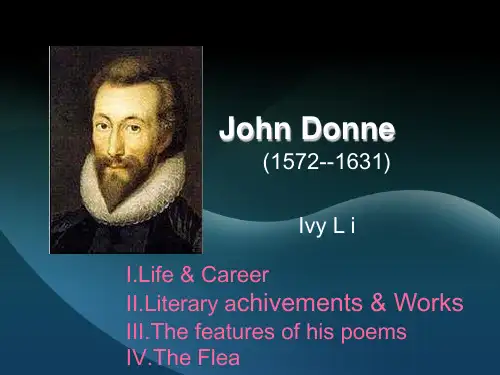
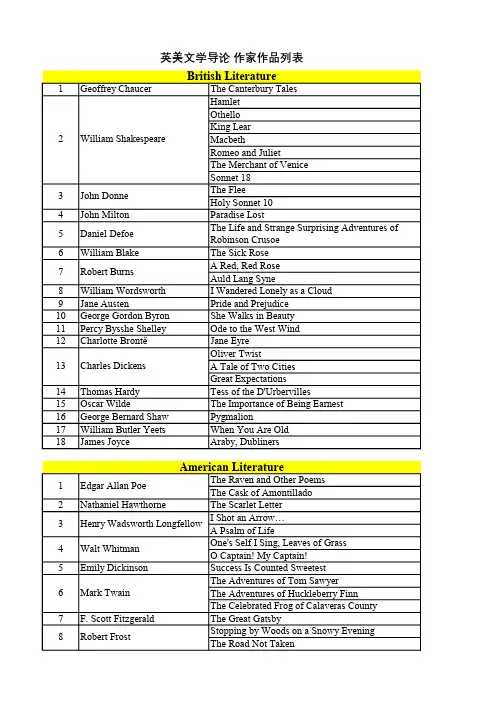
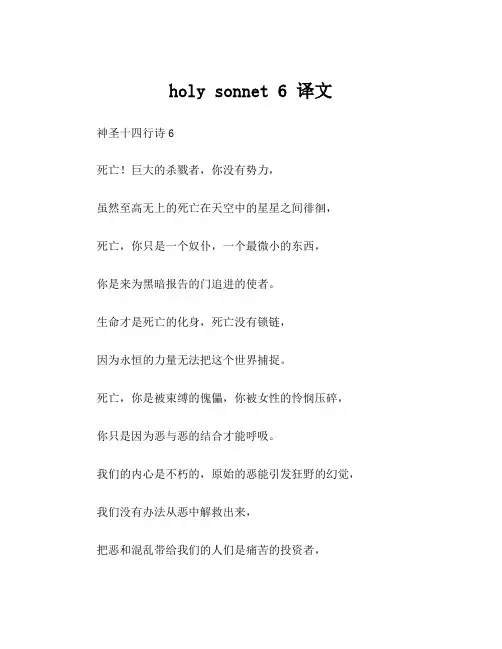
holy sonnet 6 译文
神圣十四行诗6
死亡!巨大的杀戮者,你没有势力,
虽然至高无上的死亡在天空中的星星之间徘徊,
死亡,你只是一个奴仆,一个最微小的东西,
你是来为黑暗报告的门追进的使者。
生命才是死亡的化身,死亡没有锁链,
因为永恒的力量无法把这个世界捕捉。
死亡,你是被束缚的傀儡,你被女性的怜悯压碎,你只是因为恶与恶的结合才能呼吸。
我们的内心是不朽的,原始的恶能引发狂野的幻觉,我们没有办法从恶中解救出来,
把恶和混乱带给我们的人们是痛苦的投资者,
他们的一举一动使我们的世界愈加堕落。
神对待我们慷慨而善良,他将死锁链解开,用他的爱给我们希望和新的生命。
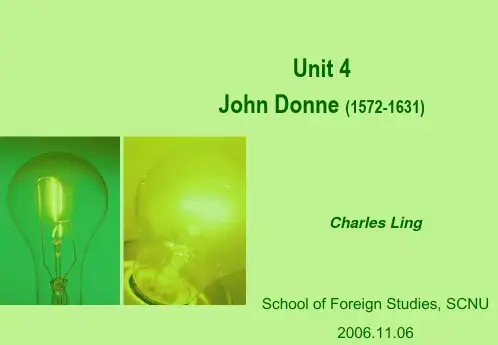
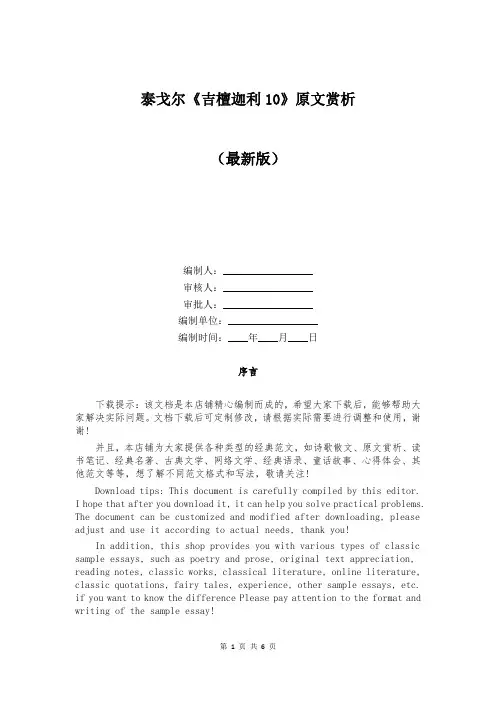
泰戈尔《吉檀迦利10》原文赏析(最新版)编制人:__________________审核人:__________________审批人:__________________编制单位:__________________编制时间:____年____月____日序言下载提示:该文档是本店铺精心编制而成的,希望大家下载后,能够帮助大家解决实际问题。
文档下载后可定制修改,请根据实际需要进行调整和使用,谢谢!并且,本店铺为大家提供各种类型的经典范文,如诗歌散文、原文赏析、读书笔记、经典名著、古典文学、网络文学、经典语录、童话故事、心得体会、其他范文等等,想了解不同范文格式和写法,敬请关注!Download tips: This document is carefully compiled by this editor.I hope that after you download it, it can help you solve practical problems. The document can be customized and modified after downloading, please adjust and use it according to actual needs, thank you!In addition, this shop provides you with various types of classic sample essays, such as poetry and prose, original text appreciation, reading notes, classic works, classical literature, online literature, classic quotations, fairy tales, experience, other sample essays, etc. if you want to know the difference Please pay attention to the format and writing of the sample essay!泰戈尔《吉檀迦利10》原文赏析【导语】:91 呵,你这生命最后的完成,死亡,我的死亡,来对我低语罢! 我天天地在守望着你;为你,我忍受着生命中的苦乐。
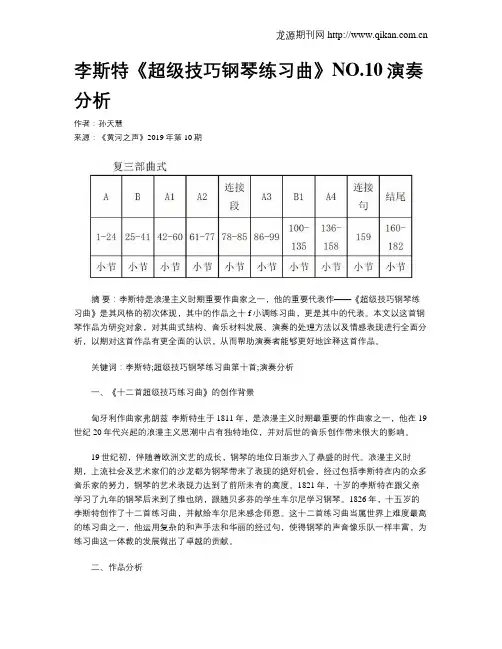
李斯特《超级技巧钢琴练习曲》NO.10演奏分析作者:孙天慧来源:《黄河之声》2019年第10期摘要:李斯特是浪漫主义时期重要作曲家之一,他的重要代表作——《超级技巧钢琴练习曲》是其风格的初次体现,其中的作品之十f小调练习曲,更是其中的代表。
本文以这首钢琴作品为研究对象,对其曲式结构、音乐材料发展、演奏的处理方法以及情感表现进行全面分析,以期对这首作品有更全面的认识,从而帮助演奏者能够更好地诠释这首作品。
关键词:李斯特;超级技巧钢琴练习曲第十首;演奏分析一、《十二首超级技巧练习曲》的创作背景匈牙利作曲家弗朗兹·李斯特生于1811年,是浪漫主义时期最重要的作曲家之一,他在19世纪20年代兴起的浪漫主义思潮中占有独特地位,并对后世的音乐创作带来很大的影响。
19世纪初,伴随着欧洲文艺的成长,钢琴的地位日渐步入了鼎盛的时代。
浪漫主义时期,上流社会及艺术家们的沙龙都为钢琴带来了表现的绝好机会,经过包括李斯特在内的众多音乐家的努力,钢琴的艺术表现力达到了前所未有的高度。
1821年,十岁的李斯特在跟父亲学习了九年的钢琴后来到了维也纳,跟随贝多芬的学生车尔尼学习钢琴。
1826年,十五岁的李斯特创作了十二首练习曲,并献给车尔尼来感念师恩。
这十二首练习曲当属世界上难度最高的练习曲之一,他运用复杂的和声手法和华丽的经过句,使得钢琴的声音像乐队一样丰富,为练习曲这一体裁的发展做出了卓越的贡献。
二、作品分析(一)曲式结构这首作品是由复三部曲式和变奏曲式组成的混合曲式。
曲式分析图如下:如图所示,其中的A、B与A1构成了复三部曲式,之后的A2、A3、A4以及B1均是对之前音乐材料的变奏。
这种曲式结构与古典主义的曲式结构相比更加自由多变,具有明显的浪漫主义音乐特征。
(二)旋律走向音乐从弱拍进入的主和弦第一转位开始向下进行,飞快的三连音倾泻而下,经过两个小节短暂的前奏后进入第一个动机,之后重复前奏与第一个动机,然后发展到了13小节的第一个音到达了高潮,又迅速重复了两次之前的动机再以顿音结束,形成一波未平一波又起的情感。

1.P1 问答Three conquests(时间+意义):1)The Roman conquest, 55 BC, civilized, Christianized2)The English conquest, 5th century, old English, starting point of English literature3)The Norman conquest, 1066, Mid-English, establishment of feudalism.2.P3选择,填空,判断Beowulf, the national epic of English people.3.P4 诗歌翻译“Thus made their mourning the men of Geatland, 坟墓周围,勇士们骑着战马,For their hero’s passing, his hearth-companions 为逝去的国王唱起挽歌,Quoth that of all the kings of earth, 高赞你的懿德,分享你的恩泽,哀叹你的陨落,Of men he was the mildest and most beloved, 人们称你为最可亲最可敬的国王,To his kin the kindest,keenest to praise.” 你对人们总是最仁爱最热心,你最渴望的就是人们对你的赞扬。
4.P5 名词解释,问答Features of Beowulf:1)The use of alliteration. (头韵)(定义:in alliterative verse, certain accented words in a line begin with the same consonant sound.)2)The use of metaphors and of understatements(隐喻)(Grendel represents forest, she-monster represents water, fire-dragon represents sky)5.P8 选择填空判断英国Romance代表作: adventures of King Arthur and his Knights of the Round Table (《亚瑟王和他的圆桌骑士》,同时也是骑士文学代表作)6.P9 问答The class nature of the romance:1)The theme of loyalty to king and lord was repeatedly emphasized in romances, asloyalty was the corner-stone of feudal morality, without which the wholestructure of feudalism would collapse.2)They were composed for the noble, of the noble, and in most cases by the poetspatronized by the noble.7.P17 选择填空名词解释The Ballads(民谣): the most important department of English folk literature.1)定义:①A ballad is a story told in song, usually in four-line stanzas, with the secondand forth lines rhymed. ②They are mainly the literature of peasants, and in them one is able to understand the outlook of the English common people in feudal society.2)代表作:The Robin Hood Ballads (罗宾汉民谣)8.P19 选择填空判断1)Geoffrey Chaucer, the founder of English poetry, was born about 1340 in London.2)The Canterbury Tales(坎特伯雷故事集) is Chaucer’s masterpiece and one of themonumental works in English literature.9.P25 问答Chaucer’s language and contribution:1)Chaucer’s language, now called Middle English, is vivid and exact. He is masterof word-pictures.2)He introduced from France the rhymed stanza of various types, especially therhymed couplet of 5 accents in iambic meter (the heroic couplet) to English poetry, instead of the old Anglo-Saxon alliterative verse.3)Chaucer did much in making the dialect of London standard for the modernEnglish speech.10.P27 问答Preparation for the English Renaissance:1)The establishment of the new monarchy2)Religious Reformation: the appearance of Protestantism3)Language and cultural preparation: the publish of English Bible11.P28 名词解释选择判断King James Bible: the authorized version of English Bible, which was made in 1611 under the auspices of James.12.P30-31名词解释问答(文艺复兴:全答;人文主义:第三点)1)Renaissance 定义:The rise of the bourgeoisie soon showed its influence in thesphere of cultural life. The result is an intellectual movement known as the Renaissance, or, the rebirth of letters. It sprang first in Italy in the 14th century and gradually spread all over Europe.2)Features of Renaissance:①The one is the thirsting curiosity for the classical literature.②The Renaissance is the keen interests in the activities of humanity.3)Humanism 定义:Humanism is the keynote of the Renaissance. It reflected the newoutlook of the rising bourgeois class, which saw the world opening before it.According to the humanists, both men and the world are hindered only by external checks from infinite improvement. Man could mould the world according to his desires, and attain happiness by removing all external checks by the exercise of reason.13.P40-42 选择判断填空1)Edmund Spenser代表作:The Faerie Queene《仙后》2)The Spenserian Stanza(斯宾塞体)定义:The Faerie Queene is written in a special verseform that consists of eight iambic pentameter lines followed by a ninth line of sixiambic feet, with the rhyme scheme ababbcbcc. This form has since been called the Spenserian Stanza.14.P43 诗歌翻译A gentle Knight was pricking(=spurring) on the plaine, 一位高贵的骑士正策马穿过平原,Y-cladd(=clad) in mightie armes and silver shielde, 他全副武装,手持银盾,Wherein old dints of deepe wounds did remain, 盾上仍留着陈旧的深深的凹痕,The cruell markes of many a bloody fielde; 这残酷的标记来自多次血腥的战阵;Yet armes till that time did he never wield: 但这些武器至今他还未用过;His angry steede did chide his foming(=foaming) bitt, 他那愤怒的坐骑暴躁地咬着马勒,As much disdayning to the curbe to yield: 似乎桀骜不驯,不愿受主人的控制;Full jolly Knight he seemed , and faire did sitt, 他看上去是位真正的骑士,端坐马上,As one for knightly giusts and fierce en counters fitt. 好像准备参加骑士比武,迎接激烈对抗。
Hamlet生存或毁灭, 这是个必答之问题:是否应默默的忍受坎苛命运之无情打击,还是应与深如大海之无涯苦难奋然为敌,并将其克服。
此二抉择, 就竟是哪个较崇高?死即睡眠, 它不过如此!倘若一眠能了结心灵之苦楚与肉体之百患,那么, 此结局是可盼的!死去, 睡去...但在睡眠中可能有梦, 啊, 这就是个阻碍:当我们摆脱了此垂死之皮囊,在死之长眠中会有何梦来临?它令我们踌躇,使我们心甘情愿的承受长年之灾,否则谁肯容忍人间之百般折磨,如暴君之政、骄者之傲、失恋之痛、法章之慢、贪官之侮、或庸民之辱,假如他能简单的一刃了之?还有谁会肯去做牛做马, 终生疲於操劳,默默的忍受其苦其难, 而不远走高飞, 飘於渺茫之境,倘若他不是因恐惧身後之事而使他犹豫不前?此境乃无人知晓之邦, 自古无返者。
所以,「理智」能使我们成为懦夫,而「顾虑」能使我们本来辉煌之心志变得黯然无光, 像个病夫。
再之, 这些更能坏大事, 乱大谋, 使它们失去魄力。
Romeo and Juliet罗密欧没有受过伤的才会讥笑别人身上的创痕。
(朱丽叶自上方窗户中出现)轻声!那边窗子里亮起来的是什么光?那就是东方,朱丽叶就是太阳!起来吧,美丽的太阳!赶走那妒忌的月亮,她因为她的女弟子比她美得多,已经气得面色惨白了。
既然她这样妒忌着你,你不要忠于她吧;脱下她给你的这一身惨绿色的贞女的道服,它是只配给愚人穿的。
那是我的意中人;啊!那是我的爱;唉,但愿她知道我在爱着她!她欲言又止,可是她的眼睛已经道出了她的心事。
待我去回答她吧;不,我不要太卤莽,她不是对我说话。
天上两颗最灿烂的星,因为有事他去,请求她的眼睛替代它们在空中闪耀。
要是她的眼睛变成了天上的星,天上的星变成了她的眼睛,那便怎样呢?她脸上的光辉会掩盖了星星的明亮,正像灯光在朝阳下黯然失色一样;在天上的她的眼睛,会在太空中大放光明,使鸟儿误认为黑夜已经过去而唱出它们的歌声。
瞧!她用纤手托住了脸,那姿态是多么美妙!啊,但愿我是那一只手上的手套,好让我亲一亲她脸上的香泽!朱丽叶唉!罗密欧她说话了。
徐志摩的诗歌及赏析徐志摩的诗歌10首及赏析徐志摩中国著名新月派现代诗人、散文家、新月诗社成员,倡导新诗格律,对中国新诗的发展做出了重要的贡献。
下面是小编收集整理的徐志摩的诗歌10首及赏析,希望对您有所帮助!1 、《偶然》我是天空里的一片云,偶尔投影在你的波心——你不必讶异,更无须欢喜——在转瞬间消灭了踪影。
你我相逢在黑夜的海上,你有你的,我有我的,方向;你记得也好,最好你忘掉,在这交会时互放的光亮!赏析:能把“偶然”这样一个极为抽象的时间副词,使之形象化,置入象征性的结构,充满情趣哲理,不但珠润玉圆,朗朗上口而且余味无穷,意溢于言外——徐志摩的这首《偶然》小诗,对我来说,用上“情有独钟”之语而不为过。
诗史上,一部洋洋洒洒上千行长诗可以随似水流年埋没于无情的历史沉积中,而某些玲珑之短诗,却能够经历史年代之久而独放异彩。
这首两段十行的小诗,在现代诗歌长廊中,应堪称别备一格之作。
这首《偶然》小诗,在徐志摩诗美追求的历程中,还具有一些独特的“转折”性意义。
按徐志摩的学生,著名诗人卡之琳的说法:“这首诗在作者诗中是在形式上最完美的一首。
”(卡之琳编《徐志摩诗集》第94页)新月诗人陈梦家也认为:“《偶然》以及《丁当-清新》等几首诗,划开了他前后两期的鸿沟,他抹去了以前的火气,用整齐柔丽清爽的诗句,来写那微妙的灵魂的秘密。
”(《纪念徐志摩》)。
的确,此诗在格律上是颇能看出徐志摩的功力与匠意的。
全诗两节,上下节格律对称。
每一节的第一句,第二句,第五句都是用三个音步组成。
如:“偶尔投影在你的波心,”“在这交会时互放的光壳,”每节的第三、第四句则都是两音步构成,如:“你不必讶异,”“你记得也好/最好你忘掉。
”在音步的安排处理上显然严谨中不乏洒脱,较长的音步与较短的音步相间,读起来纡徐从容、委婉顿挫而朗朗上口。
而我在这里尤需着重指出的是这首诗歌内部充满着的,又使人不易察觉的诸种“张力”结构,这种“张力”结构在“肌质”与“构架”之间,“意象”与“意象”之间,“意向”与“意向”之间诸方面都存在着。
单词复习2知识清单10初三英语一轮复习1.Sonnet/ ˈsɒnɪt/n十四行诗The sonnet, along with other Italian forms, was introduced to England in the sixteenth century by Sir Thomas Wyatt.十四行诗与其他意大利形式一起,在16世纪由托马斯·怀亚特爵士引入英国。
2.Deadline/ ˈdedlaɪn/n最后期限;截止日期I prefer to work to a deadline.我喜欢按规定的期限完成工作。
复数:deadlines记忆技巧:dead adj.死的+ line 线3.contest/ˈkɒntest/n比赛;竞赛;竞争The contest should be very keenly fought.比赛应该争夺很激烈。
第三人称单数:contests复数:contests现在分词:contesting过去式:contested过去分词:contested记忆技巧:con 共同,一起+ test 测试,证据4.Polish/ˈpɒlɪʃ/vt修改;润色;抛光n上光剂;抛光;擦亮Her father was a Polish count.她父亲是波兰的一位伯爵。
前缀pol光滑politeadj. 有礼貌的pol 光滑+ ite ...的5.String/strɪŋ/n细绳;线;一串He went off to change a guitar string.他离开了去换一根吉他弦。
第三人称单数:strings复数:strings现在分词:stringing过去式:strung过去分词:strung6.Wherever/weərˈevə(r)/conj在任何地方;在所有……的情况下Wherever can he have gone to?他究竟会到哪儿去了呢?记忆技巧:wher(e) 哪里,地点+ ever 究竟,永远ever究竟,永远foreveradv. 永远for prep.支持+ ever 究竟,永远whateveradv. 无论什么what 什么+ ever 究竟,永远wheneverconj. 无论何时when interrogativeadv.何时+ ever 究竟,永远7.Barren/ˈbærən/adj贫瘠的;不结果实的The land was barren and infertile.这片土地荒芜而贫瘠。
死神,你莫骄傲死神,你莫骄傲,尽管有人说你如何强大,如何可怕,你并不是这样;你以为你把谁谁谁打倒了,其实,可怜的死神,他们没死;你现在也还杀不死我。
休息、睡眠,这些不过是你的写照,既能给人享受,那你本人提供的一定更多;我们最美好的人随你去得越早,越能早日获得身体的休息,灵魂的解脱。
你是命运、机会、君主、亡命徒的奴隶,你和毒药、战争、疾病同住在一起,罂粟和咒符和你的打击相比,同样,甚至更能催我入睡;那你何必趾高气扬呢?睡了一小觉之后,我们便永远觉醒了,再也不会有死亡,你死神也将死去。
Many of the poems are believed to have been written in 1609 and 1610, during a period of great personal distress and strife for Donne who suffered a combination of physical, emotional, and financial hardships during this time. This was also a time of personal religious turmoil as Donne was in the process of conversion from Roman Catholicism to Anglicanism, and would take holy orders in 1615 despite profound reluctance and significant self-doubt about becoming a priest. In Holy Sonnets, Donne addresses religious themes of mortality, divine judgment, divine love, and humble penance while reflecting deeply personal anxieties.第一组四行诗以拟人的手法呼吁死神不要骄傲,(“Death, be not proud”)起句突兀,表达了对死神的嘲笑和蔑视,然后立刻指出死神不应骄傲的第一条理由:For those, whom thou think’st thou dost overthrow, Die not, poor Death, nor yet canst thou kill me.”第二组四行诗指出死神无需骄傲的另一条理由:死亡不过是更安逸的休息、更甜美的睡眠,“Much pleasure, then from thee much more must f low,”人们都会争着希望得到身体的休息,灵魂的解脱,“Rest of their r bones, and soul’s delivery.”第三组四行诗嘲笑死神奴隶般的从属地位:“Thou’rt slave to Fate, chance, kings, and desperate men, And dost with poison, war, and s ickness dwell,”并以罂粟和咒符来衬托死神的无能为力:“And poppy or charms can make us sleep as well, And better than thy stroke”既然这样,你何必趾高气扬呢?“why swell’st thou then?”这三组四行诗以不同的理由对死神威胁的解构确实已非同一般。
然而,接下来的偶句并不放过对死神的最后一击:睡一小觉之后,我们便永远觉醒了,再也不会有死亡,不可一世的死神将走向自身的死亡,“And Death shall be no more; Death, thou shalt die.”诗歌的说理递进模式在此戛然而止,生与死原有意义上的关系彻底逆转:死亡是瞬间的,将很快不复存在,而死后的欢乐则是永恒的,人对于死亡的畏惧变成了死亡自身的恐惧,死亡对于人来说不过是通往幸福永生的大门。
In this poem, Donne uses a variety of poetic elements. These elements function in enhancing the work’s unconventional them e of man's superiority over death.Throughout the poem, there is a strong use of assonance, the repetition of vowel sound within a phrase. The sound of the words helps in structuring Donne's writing. Nearly every line contains a repetition of "o" sounds. In the following line, an example of this device is clear: “Die not poor Death, nor yet canst thou kill me." The frequent use of assonance does not directly enhance the poem's theme, yet it does help convey its message more vividly by making the lines flow, thus allowing the reader to understand each stanza more easily. Since each individual line and its associated thought are easy to understand, the central idea of the entire poem is easy to understand too.John Donne effectively uses tone to enhance the poem's theme. The work has a tone of triumphant confidence and defiance in the face of death. Donne boldly denounces death, making it clear that he is not controlled by the fear of it as others often are. Although many may believe death to be mighty and dreadful, he feels this is not so. Donne sees death as being dependent on mankind for its survival. Death relies on fate, chance unfortunate occurrences, the legislation of kings, and the actions of desperate men to claim its victims. This dependence in itself is a weakness, in that death is not self-supporting, yet relies on certain aspects of the lives of people. Donne's final and most derogatory comment comes in the poem's final lines where he portrays death as nothing more than a transition into an eternally vast afterlife; Death is a short sleep from which we wake forever. It is nothing to fear in this situation. And, in this afterlife, death no longer exists or poses a threat. Death itself dies. All of these examples of Donne's use of tone greatly enhance the poem's theme that man is superior to death. Death's intimidation is diminished as he points out its weaknesses one by one and bravely faces it head on.It is also something not commonly personified and spoken to. The combination of a personified Death and the reference to it by means of apostrophe is very effective and crucial to the poem's theme. Donne is better able to profess (openly declare) his superiority over death by showing it as a human adversary, capable of defeat, rather than an uncontrollable natural force. His desire to prove his freedom from the imprisonment of fear is visible in the angry and arrogant monologue he presents to death in his poem. Donne’s feeling s are better expressed in a situation which people can relate to — a confrontation in which one party addresses another. The superiority theme is enhanced as a result of this man-versus –man conflict depiction.死亡是瞬间的,将很快不复存在,而死后的欢乐则是永恒的,人对于死亡的畏惧变成了死亡自身的恐惧,死亡对于人来说不过是通往幸福永生的大门。